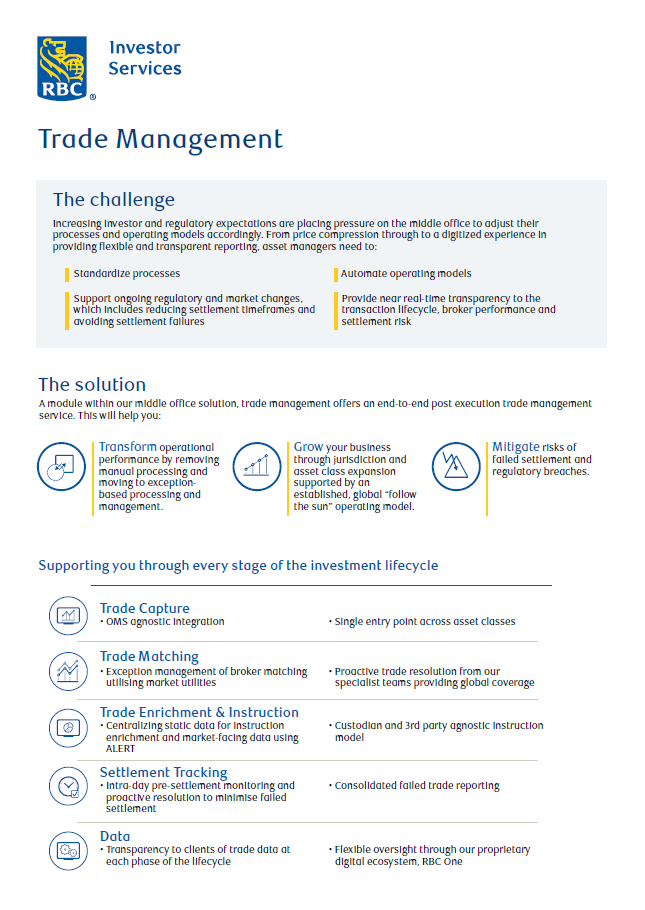As the countdown to T+1 settlement gets underway, Mario Brizar, Director of Business Development, discusses important considerations for investment managers as they prepare for the transition to a shorter settlement cycle.
In March 2023, the Canadian Capital Markets Association (CCMA) and US Securities and Exchange Commission (SEC) confirmed that T+1 settlement will be introduced for all listed equities, institutional bonds and other products in Canada and the US on May 27 and 28, 2024, respectively. This will replace the existing T+2 settlement timeframe.
T+1 comes with benefits & risks
The move to T+1 settlement offers several benefits to investment managers at a time when the industry is dealing with unprecedented volatility and cost pressures. T+1 enables firms to reduce counterparty and settlement risk, while simultaneously generating efficiencies through cash and margin optimization. In addition, the enhanced automation for T+1 will result in improved straight-through processing and related “spill-over” efficiencies that benefit the broader organization.
T+1 will enable firms to reduce counterparty and settlement risk
On the other hand, a shorter settlement cycle creates certain challenges for managers. Under T+2, firms have until noon the following day (T+1) to affirm trades with brokers and make any necessary amendments. This also provides custodians with time to process and settle the trades. With T+1 settlement, the trades must be affirmed (i.e., achieve pre-matched status) much sooner—by 9 pm ET on Trade Date to be successfully instructed to the custodian for settlement on T+1.
The shortened settlement cycle also comes with potentially negative downstream impacts on foreign exchange (FX), securities lending, collateral management and transfer agency activities. In the case of FX transactions, which currently settle on T+2, international participants buying US securities will be required to prefund the transaction with USD or arrange for a short-dated T+1 FX settlement. The prefunding requirement could affect other investments as the investor will need to sell a day earlier in order to have USD funds available for the transaction. As a result, the investment manager will be out of the market for one day.1
Time zone differences are likely to be a challenge
Time zone differences are also likely to be a challenge, particularly for managers not operating in the Eastern Time Zone. For example, with T+1, a manager located on the West Coast of North America will only have a few hours to match and reconcile a trade that is executed in the morning local time, compared to a full business day under the T+2 model.
Readiness is a concern
Preparation for T+1 appears to be a core issue. According to an industry survey conducted in early 2023, over 60% of institutional investors in Canada and the US are still in the early stages of their T+1 readiness.2 While implementation of T+1 may be more than a year down the road, this does not leave a lot of time to prepare for this change. Managers need to move quickly if they are to meet the March 2024 deadlines for implementation of T+1 across North America.
Automation is key
The transition to T+1 will require investment managers to seek solutions that reduce the reliance on legacy systems and manual processes. With T+1 looming, the onus is on managers to automate their operational processes and develop an integrated workflow for trade settlement activity. The allocation of additional human capital to address the shortened settlement cycle through existing processes is unlikely to be viable as the T+1 framework does not provide sufficient time to manually sort and settle trade exceptions.
T+1 requires solutions that reduce manual processes
In addition, the SEC has publicly stated that it ultimately wants the market to settle on T+0 and, if the US adopts this approach, other countries, including Canada, will undoubtedly follow. Failure to automate now means that managers will be unable to accommodate T+0 or other future market settlement changes.
There are options to consider
As a first step towards T+1 readiness, it is essential for managers to assess their current operating model and identify non-STP (straight-through processing) activities. This will help determine the work effort and investment required to automate trade management processes and prepare for the shortened settlement cycle.
Some managers may look to upgrade existing legacy systems while others may look to purchase new "off-the-shelf" technology solutions. Either approach could require a significant upfront investment and place demands on technology resources already consumed with other priorities. Managers will also need to consider the ongoing cost and resources to maintain new systems and perform oversight on trading activity once these systems are live.
The risks of not being ready for T+1 are significant
An alternative approach for some managers will be to explore an outsourced trade management service provided by a trusted middle office provider. In this model, managers continue to maintain their oversight controls through real-time dashboards, while the outsourced middle office service provider handles the end-to-end post-execution trade lifecycle using automated solutions.
Regardless of the path taken, it is essential for managers to begin assessing their current operating model and exploring options to prepare for the transition. With 12 months and counting to the implementation date, the risks of not being ready are likely to be significant.
T+1 checklist
- Assess current operating model to identify non-STP activity
- Evaluate options to automate and prepare for T+1
- Upgrade legacy systems
- Purchase new technology and market utilities
- Outsource to a trusted third party
Looking for help with T+1?
Find out how RBC Investor & Treasury Services' Trade Management Solution can assist you in preparing for T+1:

